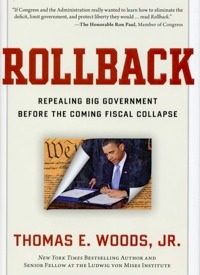
From prescription drug benefits under Medicare to the maintenance of a worldwide empire of military bases and commitments, all of the government programs and policies that have enjoyed public approval over the years and decades have piled up a national debt that now stands at more than $14 trillion, with another $1 trillion to $1.5 trillion added each year. But, Woods points out, that doesn’t count the unfunded liabilities of “off budget” programs such as Social Security and Medicare. Add those in and the debt is $111 trillion. The Congressional Budget Office has projected that annual interest payments alone on the national debt will reach nearly a trillion — $925 billion — by the year 2020. You could fund a lot of domestic programs and buy a lot of bombers and fighter planes with $925 billion, and we have been. That’s the problem. Here is one of several economic analyses quoted by Woods:
We have 78 million baby boomers who, when fully retired, will collect benefits from Social Security, Medicare and Medicaid that, on average, exceed per-capita GDP. The annual costs of these entitlements will total about $4 trillion in today’s dollars…. This is what happens when you run a massive Ponzi scheme for six decades straight, taking ever larger resources from the young and giving them to the old while promising the young their eventual run at passing the buck.
That description of Social Security and Medicare was written not by a right-wing zealot, but by Lawrence Kotlikoff, an economist at Boston University and a Democrat. Kotlikoff estimates the gap between revenue and spending commitments will reach $200 trillion and foresees three possible government responses: Benefits will be cut while the “boomers” are still alive to enjoy (or endure) their retirement; taxes will be raised so high that the young will have little incentive to work and save; or, perhaps the most frightening of all, hyperinflation by “the government simply printing vast quantities of money to cover its bills.” To which Woods adds, “More than likely, we’ll see all three.”
Woods shows how the boom and bust in housing and the crisis in the financial industry that led to the Wall Street bailouts of 2008 and 2009 were not, as many in the government and media have claimed, the result of insufficient government intervention in and regulation of private sector markets. On the contrary, the government-created entities Fannie Mae and Freddie Mac were major culprits, buying up insufficiently backed mortgages that banks would otherwise not have issued. Countrywide, for example, sold 90 percent of its mortgages to Fannie and Freddie. With the Department of Housing and Urban Development pushing “affordable lending” goals, the two agencies were backing mortgages priced well beyond borrowers’ ability to pay. The Federal Housing Administration, created to help low-income earners become homeowners, was granted authority under the Stimulus Act of 2008 to insure loans up to a maximum of $729,750. “One may well wonder what a ‘low-income’ family is doing taking on a mortgage of three quarters of a million dollars,” Woods notes. “As of this printing, some people were concerned that the limits on loans the FHA could insure would be reduced in 2011, all the way down to — wait for it — a mere $625,000.”
The Federal Reserve Board, by increasing the money supply and keeping interest rates artificially low, helped create the “boom” that led to the “bust” in the housing and financial markets. Alan Greenspan, the Federal Reserve Chairman from 1987 to 2005, acknowledged that social policy and political goals trumped sound financial practices during his reign at “the Fed.”
“I was aware that the loosening of mortgage credit terms for subprime borrowers increased financial risk, and that subsidized homeownership initiatives distort market outcomes,” he wrote in his 2008 autobiography. “But I believed then, as now, that the benefits of broadened homeownership are worth the risk.” Far from being the strict free-market capitalist described by critics and admirers alike, Greenspan was a proponent of government intervention that encouraged the “too big to fail” assumptions that, in turn, encouraged excessive risks in the financial markets. “When Alan Green-span made sure the Long Term Capital Management hedge fund was bailed out in 1998,” Woods notes, “Wall Street firms naturally concluded that if a hedge fund wasn’t allowed to fail, then surely no investment bank would be permitted to go under.”
In one area after another, Woods demonstrates how government interventions have failed to produce the promised benefits and often achieved their opposite. Highway fatalities decreased by 3.5 percent per mile per year, between 1925 and 1960, before seatbelts were required in every new car and when “safety regulations were essentially nil,” Woods says. So what is the rate of decrease in fatalities per mile in the current era of seat belt and air bag requirements and a network of National Highway Safety Administration regulations? “Would you believe 3.5 percent per year?” Woods finds that in the quarter century preceding the establishment in 1970 of the Occupational Safety and Health Administration, with all its regulations and time-consuming inspections, “the decline in workplace fatalities was 70 percent higher than in the quarter century that followed.” Given the salary differentials required to attract workers to high-risk jobs and the cost of worker compensation for injured employees, businesses have a much greater incentive to improve workplace safety than OSHA inspections and fines provide, Woods argues.
Energy “deregulation” was blamed for the rolling blackouts that plagued California during the latter part of the 1990s, when, in actuality, government controls were the culprit, Woods says. While wholesale prices of electricity were allowed to fluctuate, the state enforced controls on retail prices and allowed no new plants to be built, despite a sharp increase in demand from a growing population and a thriving computer industry. Several existing plants were even shut down in response to lobbying by environmental groups. “Thus with demand rising, supply not allowed to expand, and with providers unable to price electricity in accordance with these conditions, the result was rolling blackouts. This is surprising?” Woods asks.
On military spending, the country is actually getting “less bang for the (borrowed) buck,” Woods says, noting that despite a 43 percent increase in the Air Force budget, “the combat air fleet shrank by 51 percent. In 1998, the Navy had 333 battleforce ships. In 2010, the Navy had 287 such ships. In the Army, a 55 percent funding increase yielded three more brigade combat equivalents — in other words, an increase of a mere 7 percent.” When the cost of the Iraq and Afghanistan wars are figured into defense costs, the nation spent $948.7 billion on the military for 2009. About $250 billion a year is spent on maintaining 865 facilities in more than 40 countries, and 190,000 troops in 46 countries and territories. Our enemies in the “war on terrorism,” meanwhile, are waging war with homemade bombs. “We are continuing in the same policy to make America bleed profusely to the point of bankruptcy,” Osama bin Laden boasted in 2004. His strategy appears to be working.
In all, Woods has packed a great deal of information about what has gone wrong into a slender volume of 188 pages. The final chapter of Rollbackoffers suggested remedies that will make defenders of “good government” gasp. He recommends letting retirees opt out of Social Security and Medicare in exchange for complete exemption from income, gift, and estate taxes. He favors across-the-board spending cuts that will spare no “sacred cows” among entitlement or defense programs and favors state nullification of unconstitutional laws. He suggests the selling of government assets, including vast amounts of federally owned lands. And if all of that fails, there is always the possibility of repudiating — openly defaulting on — the national debt. That will greatly reduce the opportunity for future borrowing, which would be a good thing, he maintains, noting Thomas Jefferson wanted a constitutional amendment to prohibit government borrowing. Today the cost of political decisions made by previous generations “who enjoyed a nice ride while it lasted,” is left to be paid by Americans now in their twenties and thirties, says Woods, himself a 30-something author of 11 books.
“It will be paid for by us if we choose to pay it, that is,” he says. “The federal government may have ruined the job market and made the lives of young people difficult to impossible, but this need not be a permanent feature of American life. The sooner that younger generation liberates itself from the philosophy of plunder and intervention that has led us to this point, the better our prospects will be.”
Rollback: Repealing Big Government Before the Coming Financial Collapse, by Thomas E. Woods, Jr., Regnery Publishing Inc., 2011, 232 pages, hardcover.



